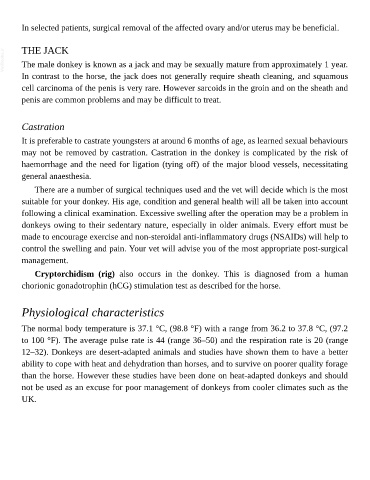Page 1037 - The Veterinary Care of the Horse
P. 1037
In selected patients, surgical removal of the affected ovary and/or uterus may be beneficial.
VetBooks.ir THE JACK
The male donkey is known as a jack and may be sexually mature from approximately 1 year.
In contrast to the horse, the jack does not generally require sheath cleaning, and squamous
cell carcinoma of the penis is very rare. However sarcoids in the groin and on the sheath and
penis are common problems and may be difficult to treat.
Castration
It is preferable to castrate youngsters at around 6 months of age, as learned sexual behaviours
may not be removed by castration. Castration in the donkey is complicated by the risk of
haemorrhage and the need for ligation (tying off) of the major blood vessels, necessitating
general anaesthesia.
There are a number of surgical techniques used and the vet will decide which is the most
suitable for your donkey. His age, condition and general health will all be taken into account
following a clinical examination. Excessive swelling after the operation may be a problem in
donkeys owing to their sedentary nature, especially in older animals. Every effort must be
made to encourage exercise and non-steroidal anti-inflammatory drugs (NSAIDs) will help to
control the swelling and pain. Your vet will advise you of the most appropriate post-surgical
management.
Cryptorchidism (rig) also occurs in the donkey. This is diagnosed from a human
chorionic gonadotrophin (hCG) stimulation test as described for the horse.
Physiological characteristics
The normal body temperature is 37.1 °C, (98.8 °F) with a range from 36.2 to 37.8 °C, (97.2
to 100 °F). The average pulse rate is 44 (range 36–50) and the respiration rate is 20 (range
12–32). Donkeys are desert-adapted animals and studies have shown them to have a better
ability to cope with heat and dehydration than horses, and to survive on poorer quality forage
than the horse. However these studies have been done on heat-adapted donkeys and should
not be used as an excuse for poor management of donkeys from cooler climates such as the
UK.

